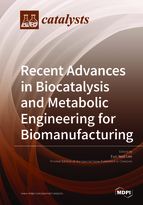Recent Advances in Biocatalysis and Metabolic Engineering for Biomanufacturing
A special issue of Catalysts (ISSN 2073-4344). This special issue belongs to the section "Biocatalysis".
Deadline for manuscript submissions: closed (31 March 2019) | Viewed by 93142
Special Issue Editor
Special Issue Information
Dear Colleagues,
The use of biocatalysts, including enzyme and metabolically engineered cells, has attracted a great deal of attention in chemical and bioindustry because biocatalytic reactions can be conducted under environmentally-benign conditions and in sustainable ways. The catalytic efficiency and chemo-, regio-, stereoselectivity of enzyme can be readily enhanced and modulated using protein engineering. Metabolic engineering seeks to enhance cellular biosynthetic productivity of target metabolites via controlling and redesigning metabolic pathways using multi-omics analysis, genome-scale modeling, metabolic flux control and reconstruction of novel pathways.
The aim of this Special Issue is to deal with the recent advances in biocatalysis and metabolic engineering for biomanufacturing of fuels, chemicals, biomaterials, and pharmaceuticals. Reviews and original research papers on the development of new strategies to improve the catalytic efficiency of enzyme, biosynthetic capability of cell factory and their applications in production of various bioproducts and chemicals are welcome.
Prof. Eun Yeol Lee
Guest Editor
Manuscript Submission Information
Manuscripts should be submitted online at www.mdpi.com by registering and logging in to this website. Once you are registered, click here to go to the submission form. Manuscripts can be submitted until the deadline. All submissions that pass pre-check are peer-reviewed. Accepted papers will be published continuously in the journal (as soon as accepted) and will be listed together on the special issue website. Research articles, review articles as well as short communications are invited. For planned papers, a title and short abstract (about 100 words) can be sent to the Editorial Office for announcement on this website.
Submitted manuscripts should not have been published previously, nor be under consideration for publication elsewhere (except conference proceedings papers). All manuscripts are thoroughly refereed through a single-blind peer-review process. A guide for authors and other relevant information for submission of manuscripts is available on the Instructions for Authors page. Catalysts is an international peer-reviewed open access monthly journal published by MDPI.
Please visit the Instructions for Authors page before submitting a manuscript. The Article Processing Charge (APC) for publication in this open access journal is 2700 CHF (Swiss Francs). Submitted papers should be well formatted and use good English. Authors may use MDPI's English editing service prior to publication or during author revisions.
Keywords
- Biocatalysis
- Biocatalytic reaction
- Protein Engineering
- Metabolic Engineering
- Molecular Biotechnology
- Biomass
- Biorefinery
- Immobilization
- Cell factory
- Biomanufacturing






